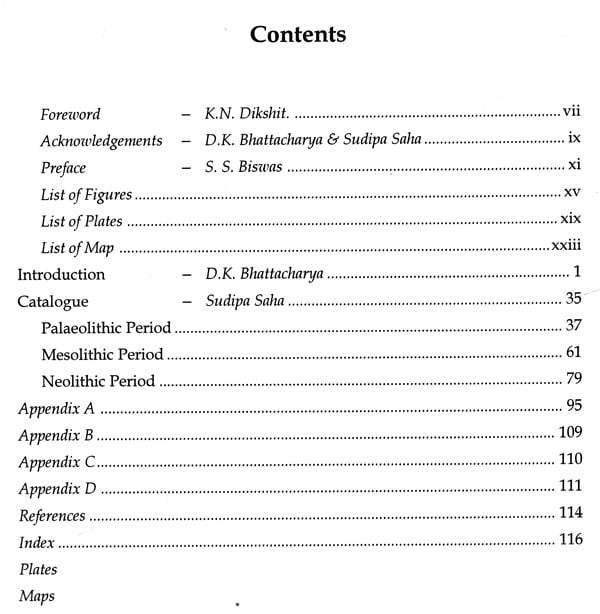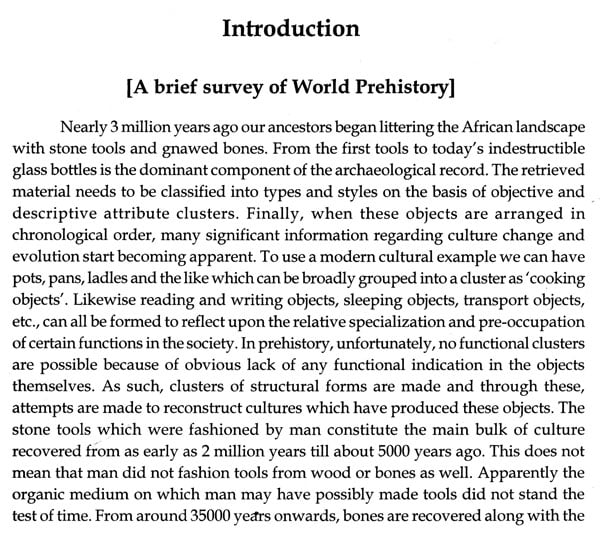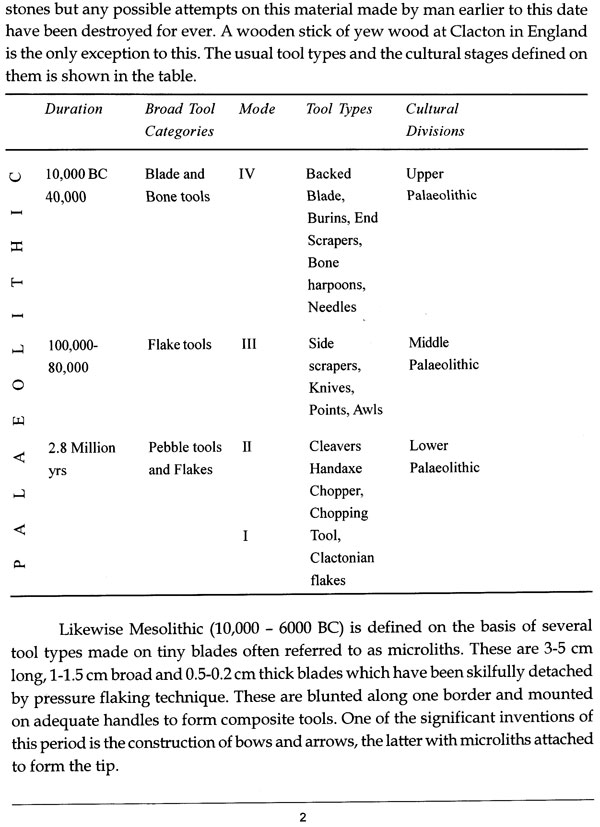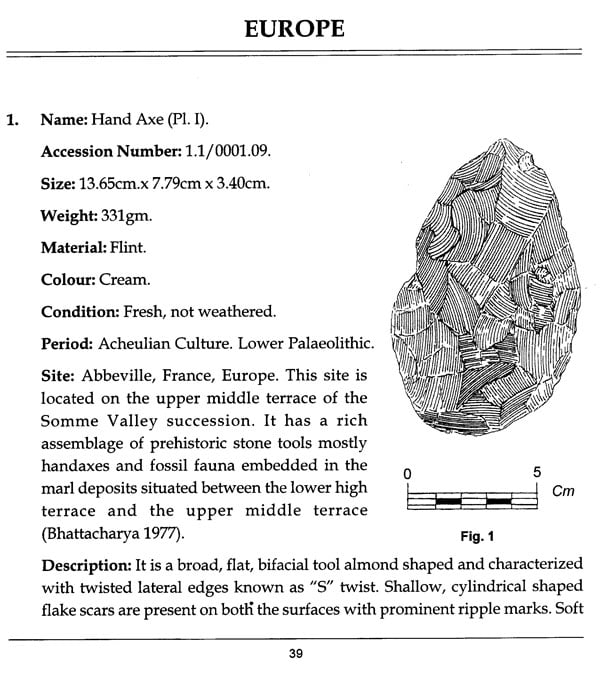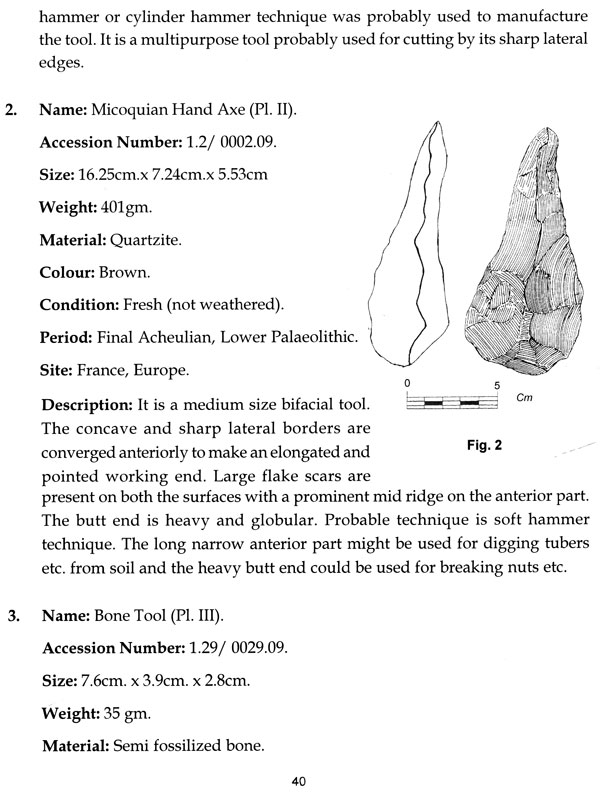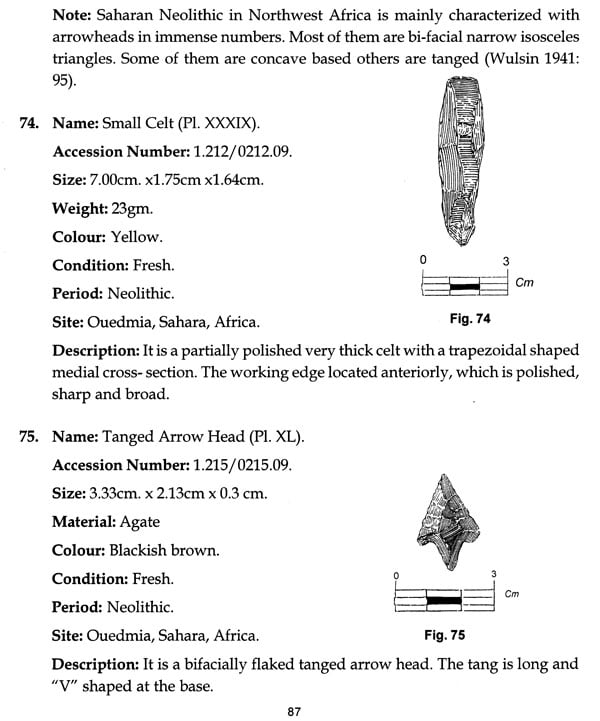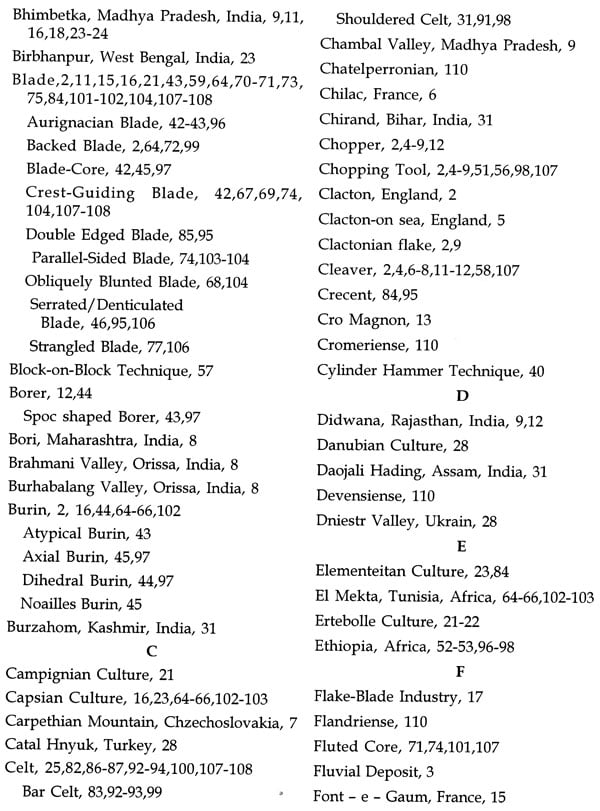
A Catalogue of Prehistoric Tools (Indraprastha Museum of Art and Archaeology)
Book Specification
| Item Code: | NAR549 |
| Author: | Prof. D. K. Bhattacharya and Ms. Sudipa Saha |
| Publisher: | Indraprastha Museum of Art and Archaeology, New Delhi |
| Language: | English |
| Edition: | 2010 |
| ISBN: | 9788191063509 |
| Pages: | 172 (85 B/W and 45 Color Illustrations) |
| Cover: | HARDCOVER |
| Other Details | 11.00 X 9.00 inch |
| Weight | 930 gm |
Book Description
This monograph 'A Catalogue of Prehistoric Tools' is a unique presentation of a rare and important collection donated by Late Dr. A.P. Khatri to the Indraprastha Museum of Art and Archaeology, New Delhi. The entire collection comprises of thousands of prehistoric tools from different parts of the world including rich river (Narmada, Godavari etc.) valley collection from India.
A selection of the representative types has been made from most of the sites distributed in four continents of the world namely, Europe, Africa, Asia and America. These tools are included in the catalogue and elaborately described with good line drawings. In some cases notes are also given to place the collection in their proper context. Appendices with relevant information and maps are to highlight the text. Colour photographs of all these tools are illustrated in the plates at the end.
An introduction 'A Brief Survey of World Prehistory' has been provided as background study.
The catalogue will enormously benefit the scholars, researchers and students of Prehistoric Archaeology.
Prof. D. K. Bhattacharya (b.1939) is an eminent scholar in Prehistoric Archaeology. He passed M.Sc. (1960) in Anthropology and Ph.D. (1965) from the University of Delhi. He served the Dept. of Anthropology as Lecturer in Lucknow University for two years and joined the University of Delhi in the same capacity in 1966. He became the Professor in the Dept. of Anthropology, Delhi University and continued to teach till 2004. He has written number of books on Prehistoric Archaeology such as (i) Palaeolithic Europe: A summary of some important finds with special reference to Central Europe, (1977) (ii) The Emergence of Culture in Europe, (1978) (iii) An Outline of Indian Prehistory, (1989 & 1996) (iv) Steps to Indian Prehistory, (1994) and several articles. Prof. Bhattacharya is presently serving as Visiting Professor to several Universities and also associated as member of many educational organisations.
Ms. Sudipa Saha (b. 1981) is a young promising scholar in the field of Anthropology and Archaeology. She had obtained her Masters Degree (2004) from the University of Calcutta in Anthropology; Post Graduate Diploma in Archaeology (2006) from Deccan College, Pune as well as from the Institute of Archaeology (2009), Archaeological Survey of India, New Delhi. Ms. Saha served the Indian Archaeological Society, New Delhi as a Research Associate engaged in documenting the antiquities especially the Prehistoric collection of the Indraprastha Museum of Art and Archaeology which resulted into the present catalogue of Prehistoric tools. She was also associated with editing 'Puratattva’ the annual journal of the Society as also contributing 'Book Review' in it. Ms. Saha had participated as an Indian delegate in the 19th Indo-Pacific Prehistory Association Congress held at Hanoi, Vietnam in 2009. She is presently working in Indira Gandhi National Centre for Arts (IGNCA), New Delhi as a Jr. Research Fellow in Life Style Studies.
The volume originally planned to be a descriptive guide to the re-organised museum, theme being the evolution of man and the growth of civilization till early historic period. However, all realized the value and the need of a descriptive catalogue of one of the most hitherto systematically unpublished collection of prehistoric tools, collected by Dr. A.P. Khatri and now preserved in the Indian Archaeological Society, Nov Delhi. It has been rightfully thought that scholars, students and the public interested in the field have the right to know about this important collection and hence writing of this volume was entrusted to our two colleagues, Prof. D.K. Bhattacharya and Ms. Sudipa Saha. I congratulate them for putting their best of knowledge and ability to prepare this volume. I am confident that this shall be a welcome monograph useful to scholars, students and even interested readers.
I take this opportunity to thank Dr. S. S. Biswas who is responsible for re-organising the museum and is the inspiration behind this project.
However, it is a matter of regret that Dr. A. P. Khatri, the collector of this unique human creation of early age and Dr. S.P. Gupta responsible for caring and preserving them did not live to see this volume published.
Notwithstanding the fact that my study of Pre-historic Archaeology is quite limited, I venture to write the preface of this monograph, a catalogue of one single largest collection of prehistoric tools, now preserved in the Indraprastha Museum of Art and Archaeology of the Indian Archaeological Society, New Delhi. The collection was gifted by an outstanding scholar on prehistoric studies, Dr. A. P. Khatri. He was a committed field worker. Initially he concentrated his investigations along Narmada Valley and later extended this work into Shivna, Tapti, Mahanadi and even Godavari Valleys. At a later date, he got interested in the Middle Siwalik deposits of Punjab and Himachal Pradesh. In all these sustained surveys numerous prehistoric tools as well as rich Pleistocene fossils were collected by him. All his collection of prehistoric tools from each of the river valleys are now housed in the Museum.
The speciality of Dr. Khatri's collection lies in the his that here is a complete and comprehensive record of Pleistocene material, both palaeontological as well as archaeological, obtained from the Pleistocene beds of the river Narmada and its tributaries. This collection is of additional importance because most of these fossiliferous beds have either been already submerged or are going to be so when all the dams across Narmada become operative.
One of the most remarkable aspects of Dr. Khatri's collection of prehistoric antiquities housed in this museum is the European specimens ranging from Lower Palaeolithic to Neolithic period. Students of prehistory in India lay the foundation of their learning on the basis of Gabjiel de Mortilett's classification of various cultural traditions. The character, distribution and succession of these traditions are based on classic sites in France. He had also collected tools from Africa and different other countries of Asia which are displayed in the museum.
The catalogue has been written by our two colleagues. Prof. D. K. Bhattacharya, well known for his contribution in the study of Pre-historic archaeology has written the introductory part of the volume, which is most valuable as it provides a graphic description of human evolution and their dispersal throughout the world. He has shown this in the context of different continents. The gradual evolution of human skill for making stone tools as per advancement of knowledge and skill as also for their livelihood requirements are also demonstrated. The author has explained all these in a simple and lucid language to make it understandable to one and all. The descriptive catalogue has been prepared by Ms. Sudipa Saha, a promising young scholar of prehistoric archaeology. The catalogue however, is the most important content of this volume. This is the basic and original work successfully attempted by Ms. Saha. The description with details of every tool has been written with meticulous care and right choice of words along with the drawings of each tool. Plates in the end are well illustrated adding further value of the book. Ms. Saha has shown quite maturity in preparing the catalogue. The catalogue, it is hoped, shall be useful to scholars as well as students for further studies on the subject.
The Museum has now been fully re-organized presenting a panorama of pictorial visuals, original stone tools, replicas of potteries and terracottas etc. from prehistoric age through early historic period. The presentation is aiming at a gradual evolution of man and his culture through ages.
The catalogue has been presented to provide a comprehensive description of the ascent of man and the details of stone tools M the museum. I hope that the museum and the catalogue shall be welcome addition to the activities of the Society.
**Contents and Sample Pages**
